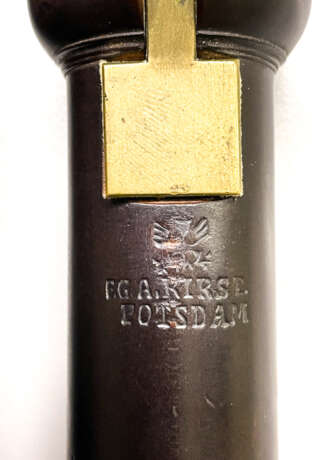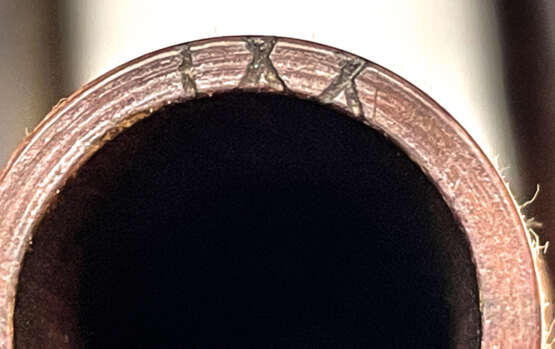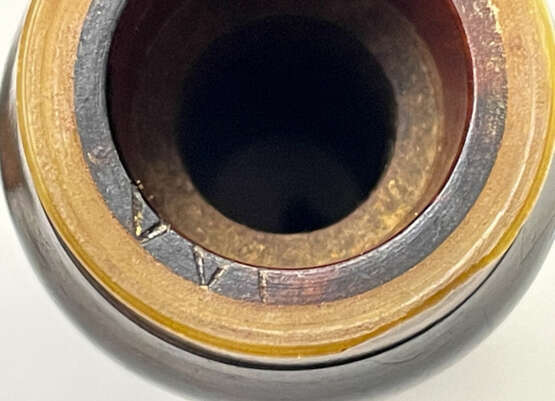ID 909832
Lot 85 | DEUTSCHE TRAVERSFLÖTE VON FRIEDRICH GABRIEL AUGUST KIRST, POTSDAM UM 1780
Estimate value
€ 3 400 – 6 800
Die Traversflöte wurde vom berühmten Flötenbauer Friedrich Gabriel August Kirst um 1780 in Potsdam gefertigt. Alle Segmente der Flöte sind mit dem preußischen Adler gestempelt. Darunter signiert der Erbauer mit „F. G. A. KIRST“. Auf den Mittelstücken sowie auf dem Fußstück findet sich zusätzlich noch die Ortsangabe „POTSDAM“. Die Werkstatt von Friedrich Gabriel August Kirst wurde unter seinem Namen zwischen 1772 bis 1804 in Potsdam geführt. Kirst war vor allem für seine Flöteninstrumente bekannt und arbeitete sowohl mit dem Flöte spielenden König Friedrich II und dessen Armee zusammen, als wohl auch mit Johann Joachim Quantz. Die Klappenfeder ist ins Holz eingezogen und nicht wie bei späteren Instrumenten direkt mit der Klappe verschraubt oder vernietet. Diese Konstruktion lässt auf eine frühe Entstehungszeit um 1780 schließen.
Die Flöte wurde aus dunkel gebeiztem Buchsbaum gefertigt. Es finden sich römische Nummern IXX auf den Zapfenenden und unter der Klappe eingefeilt. Die Klappe besteht aus Messing, die Ringe bestehen aus Kuhhorn.
Die Flöte befindet sich in einem sehr guten, gepflegten und restaurierten Zustand und ist spielbar. Besonders mit Mittelstück Nr.2 (a1≈430Hz) bietet sie hervorragende Spieleigenschaften. Das Mundloch ist original erhalten, es zeigt keinerlei Anzeichen einer Veränderung. Die Klappe scheint original und zeigt die typische Profilierung der Kirst’schen Werkstatt. Die Flöte befindet sich in einem sekundären Etui in Form eines Buches, welches offensichtlich für dieses Instrument speziell gefertigt worden ist.
Die vierteilige Flöte besitzt insgesamt drei Mittelstücke (corps de rechange) zur Änderung der Stimmtonhöhe. Auf Mittelstück Nr. 1 sind die römischen Markierungen auf den Zapfenenden nicht zu finden. Dieses Mittelstück scheint minimal eingekürzt.
Eine schriftliche Begutachtung durch Martin Wenner 2022 liegt vor und bescheinigt ein Instrument von großer Bedeutung.
Abmessungen: Mundloch: 8,57 x 9,84 mm, Gesamtlänge mit längstem Mittelstück (Nr. 3): 63cm, Schwingende Länge (Mundlochmitte bis Ende, ca.): mit Mittelstück Nr. 1: 545mm, Stimmung a1≈423Hz, mit Mittelstück Nr. 2: 538mm, Stimmung a1≈430, mit Mittelstück Nr. 3: 530 mm, Stimmung a1≈437Hz.
IMPORTANT GERMAN FLUTE BY FRIEDRICH GABRIEL AUGUST KIRST, POTSDAM CIRCA 1780
This flute was made by famous flute maker Friedrich Gabriel August Kirst in Potsdam around 1780. All segments of the flute are stamped with the Prussian eagle. Underneath, the maker signed it "F. G. A. KIRST". On the middle pieces as well as on the foot piece there is the additional inscription "POTSDAM". The workshop of Friedrich Gabriel August Kirst was run under his name in Potsdam between 1772 and 1804. Kirst was especially known for his flute instruments and worked with the flute-playing King Frederick II and his army, as well as probably with Johann Joachim Quantz. The key spring is drawn into the wood and not directly screwed or riveted to the key as in later instruments. This construction suggests an early date of origin around 1780.
The flute was made of dark stained boxwood. There are filed Roman numbers IXX on the ends of each segment and under the key. The key is made of brass, the rings are made of cow horn.
The flute is in a very good, well cared for and restored condition and is playable. Especially with middle joint no.2 (a1≈430Hz) it offers excellent playing characteristics. The mouth hole is original and shows no signs of alteration. The key seems original and shows the typical profiling of Kirst's workshop.
The flute is in a secondary case in the shape of a book, which was obviously made especially for this instrument.
The four-part flute has a total of three middle pieces (corps de rechange) for changing the pitch. On middle piece no. 1 the Roman markings on the segment ends are not to be found. This middle piece appears to be minimally shortened. A written appraisal by Martin Wenner 2022 is available and certifies an instrument of great importance.
Dimensions: Mouth hole: 8.57 x 9.84 mm, total length with longest middle piece (No. 3): 63cm, swinging length (mouth hole centre to end, approx.): with centre piece no. 1: 545mm, tuning a1≈423Hz, with centre piece no. 2: 538mm, tuning a1≈430, with centre piece no. 3: 530 mm, tuning a1≈437Hz.
| Auction house category: | Musical instruments and accessories |
|---|
| Auction house category: | Musical instruments and accessories |
|---|
| Address of auction |
Galerie Moenius AG Kirchstraße 1 56653 Wassenach Germany | |
|---|---|---|
| Preview |
| |
| Phone | +4915782646146 | |
| Conditions of purchase | Conditions of purchase | |
| Shipping |
Postal service Courier service pickup by yourself | |
| Payment methods |
Wire Transfer |









